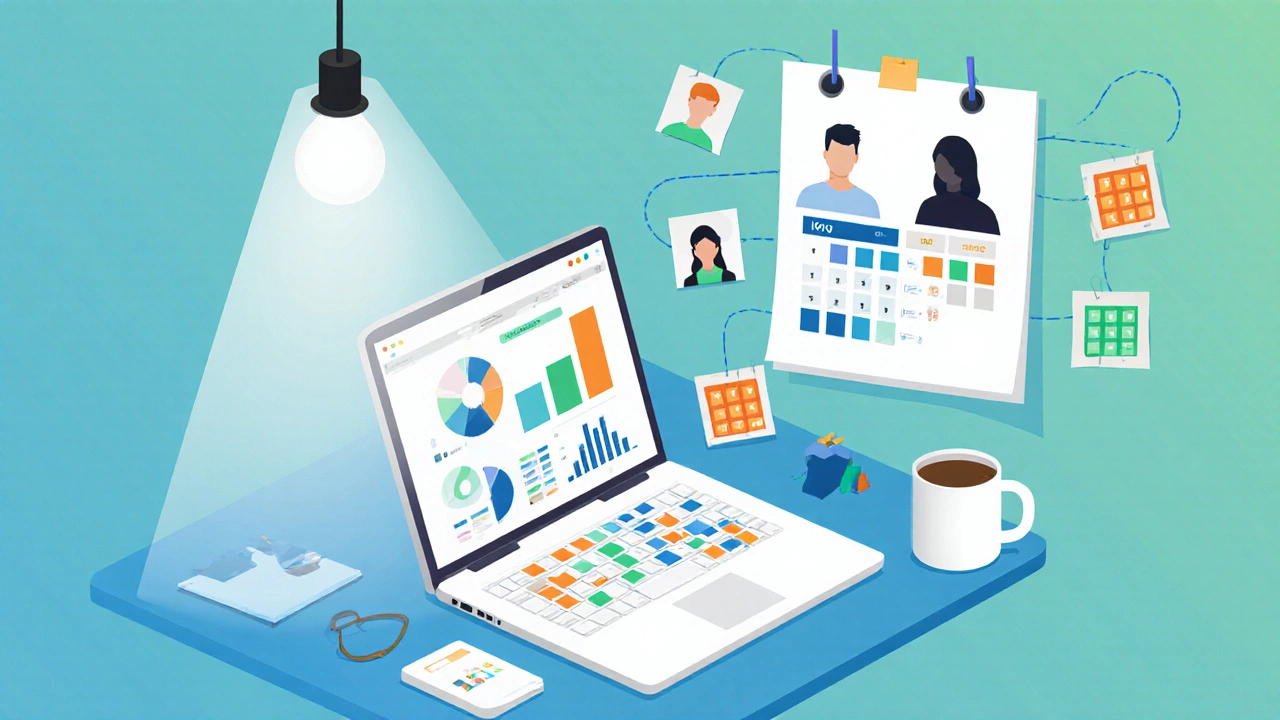Digital Marketing ROI Calculator
Calculate Your Marketing ROI
Estimate returns based on 2025 industry data. Allocate your budget across channels to see potential results.
SEO Allocation (Low cost, high long-term ROI)
Typical ROI: 5x
Email Marketing (Very high ROI)
Typical ROI: 42x
Social Media (Medium cost, medium ROI)
Typical ROI: 2x
PPC Advertising (High cost, variable ROI)
Typical ROI: 1.5x
Estimated Results
Total ROI: 0xRecommendation:
Based on your allocations, this strategy shows optimal ROI potential.
Digital Marketing is a set of online tactics that help businesses attract, engage, and convert customers through multiple digital channels. It blends creativity with data, letting you reach the right audience at the right time without spending a fortune on traditional ads. Whether you’re a solo entrepreneur or part of a growing team, mastering this craft can turn clicks into loyal fans.
In this guide we’ll walk through the whole process-from defining goals to picking the right tools-so you can build a strategy that actually moves the needle. digital marketing isn’t a buzzword; it’s a toolbox you can fill with proven techniques and adapt as the internet evolves.
What Exactly Is Digital Marketing?
Think of digital marketing as a multi‑lane highway. Each lane-search, social, email, paid ads-carries traffic that can be routed toward a common destination: your business objectives. The key is knowing which lane suits your product, budget, and audience.
Core Pillars of a Strong Strategy
- Audience Insight: Who are you talking to? Build personas based on age, interests, buying behavior, and pain points.
- Content Value: Offer something useful-how‑to guides, videos, infographics-that solves a problem or entertains.
- Channel Selection: Choose platforms where your audience hangs out, whether it’s Google, Instagram, or LinkedIn.
- Data‑Driven Optimization: Track, measure, and tweak. Small changes add up to big gains.
Creating a Winning Digital Marketing Plan
- Set clear, measurable goals (e.g., 20% more newsletter sign‑ups in three months).
- Map the customer journey-from awareness to purchase-and identify touchpoints.
- Select the right mix of channels based on audience insight.
- Develop a content calendar that aligns with each stage of the journey.
- Allocate budget and assign responsibilities.
- Implement tracking (UTM parameters, conversion pixels) before you launch.
- Review performance weekly, adjust tactics, and repeat.

Channel Deep Dives
Below we explore the most popular channels, how they work, and when they shine.
Search Engine Optimization (SEO) is the practice of optimizing website content so search engines rank it higher for relevant queries. In 2025, Google’s AI‑driven algorithm favors E‑A‑T (expertise, authority, trust) and user‑centric signals like page speed and mobile friendliness. Social Media Marketing (SMM) leverages platforms such as Instagram, TikTok, and LinkedIn to build brand awareness, drive traffic, and nurture communities. Short‑form video has become the dominant format, especially for Gen Z. Email Marketing remains one of the highest‑ROI channels, delivering an average 4,200% return on investment according to the 2024 DMA report. Personalization and automation are the new standards. Pay‑Per‑Click Advertising (PPC) lets you buy immediate visibility on search engines and social platforms. With AI bidding tools, you can optimize cost‑per‑click (CPC) in real time. Content Marketing focuses on creating valuable, relevant assets that attract and retain a clearly defined audience. Blog posts, podcasts, and interactive quizzes all fall under this umbrella. Marketing Automation platforms such as HubSpot or ActiveCampaign streamline repetitive tasks-lead nurturing, scoring, and reporting-so marketers can focus on strategy.Channel Comparison Table
| Channel | Typical Cost | Average ROI | Best KPI | Ideal For |
|---|---|---|---|---|
| SEO | Low (time‑intensive) | High (long‑term) | Organic Traffic | Brand authority & lead generation |
| Social Media | Medium (ad spend + content creation) | Medium | Engagement Rate | Community building & brand awareness |
| Low (platform fees) | Very High | Conversion Rate | Retention & upselling | |
| PPC | High (budget‑driven) | Variable | Cost‑per‑Acquisition | Quick traffic & testing |
Measuring Success: Analytics & KPIs
Data is the north star of digital marketing. Without it, you’re guessing. Use Google Analytics 4, custom dashboards, and platform‑specific insights to track performance.
- Traffic Sources: Know where visitors come from-organic, paid, referral, social.
- Conversion Rate: Percentage of visitors who complete a goal (purchase, signup, download).
- Customer Acquisition Cost (CAC): Total spend divided by new customers acquired.
- Lifetime Value (LTV): Revenue expected from a customer over the entire relationship.
- Engagement Metrics: Time on page, scroll depth, video completion rate.
Set benchmarks based on industry reports (e.g., eMarketer’s 2025 digital ad spend data) and aim to improve them month over month.
Common Pitfalls and How to Avoid Them
- Chasing Vanity Metrics: Likes and followers look good but don’t drive revenue. Focus on leads, sales, and ROI.
- Ignoring Mobile Users: Over half of web traffic now comes from phones. Ensure fast loading times and responsive design.
- One‑Size‑Fits‑All Content: Tailor messages to each stage of the funnel. A blog post isn’t the same as a retargeting ad.
- Neglecting Data Hygiene: Clean email lists regularly to avoid high bounce rates and spam complaints.
- Over‑Automation: Automate repetitive tasks, but keep human touch for high‑value interactions.

Toolbox: Must‑Have Platforms in 2025
Here’s a quick rundown of tools that simplify the heavy lifting:
- Google Analytics 4 - Unified reporting across web and apps.
- HubSpot CRM - Free contact management with built‑in marketing automation.
- Ahrefs - SEO research, backlink tracking, and content gap analysis.
- Canva Pro - Easy visual creation for social posts and ads.
- Zapier - Connects apps to automate workflows without code.
- Meta Ads Manager - AI‑driven budget allocation for Facebook and Instagram campaigns.
Checklist for Your First Campaign
- Define SMART goals (Specific, Measurable, Achievable, Relevant, Time‑bound).
- Develop detailed buyer personas.
- Choose 2‑3 primary channels based on audience.
- Create a 3‑month content calendar.
- Set up tracking - UTM parameters, conversion pixels.
- Launch a small‑scale test (A/B test ad copy, subject lines, landing pages).
- Analyze results, refine targeting, scale successful tactics.
Next Steps
Ready to put theory into practice? Start by auditing your existing online presence. Identify which of the core pillars need work, pick one channel to improve first, and use the checklist above to guide your actions. Remember, digital marketing is a marathon, not a sprint-steady iteration wins.
How long does it take to see results from SEO?
SEO is a long‑term game. Most businesses notice measurable traffic growth within 3‑6 months if they publish quality content weekly and earn backlinks consistently.
Is email marketing still worth the effort?
Absolutely. With a median ROI of over 4,200%, email remains the top channel for nurturing leads and driving repeat purchases, especially when you segment lists and automate follow‑ups.
What budget should I allocate to PPC as a small business?
Start modestly-$5‑$10 per day per platform. Use AI bidding tools to maximize conversions, and scale only after you’ve proven a positive cost‑per‑acquisition (CPA) trend.
Which social platform gives the best ROI for B2B companies?
LinkedIn tends to outperform other networks for B2B lead generation due to its professional audience and precise targeting options.
How can I measure the success of my content marketing?
Track metrics like organic traffic, time on page, social shares, and conversion rates from gated assets (e‑books, webinars). A rise in qualified leads signals effective content.





